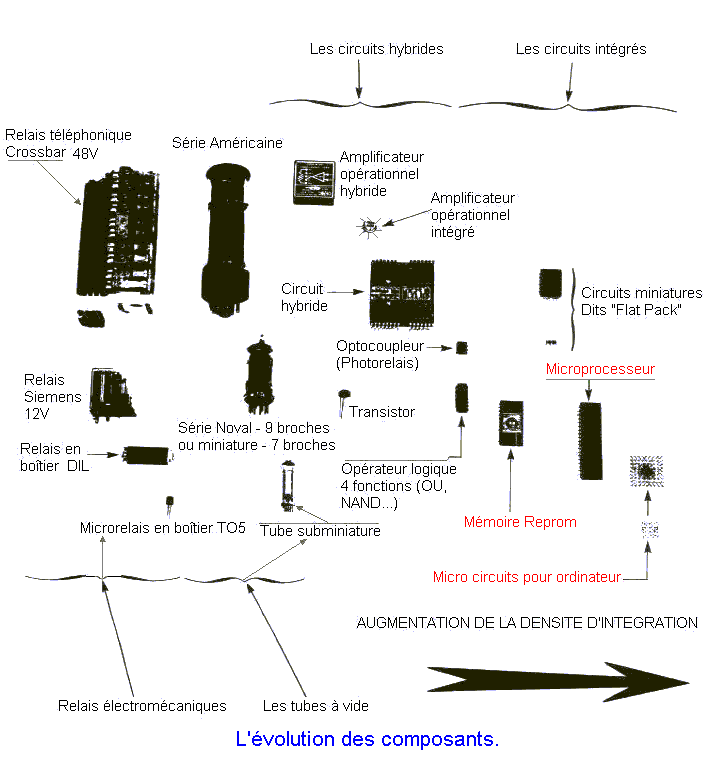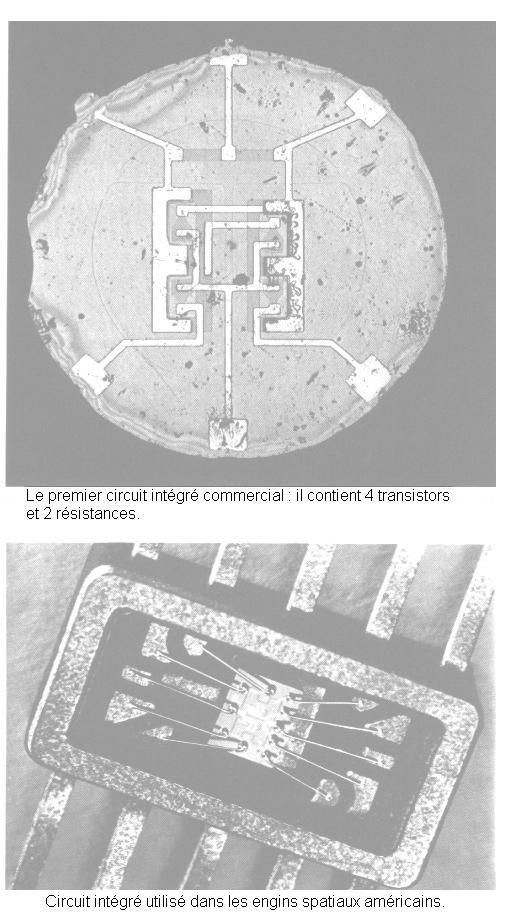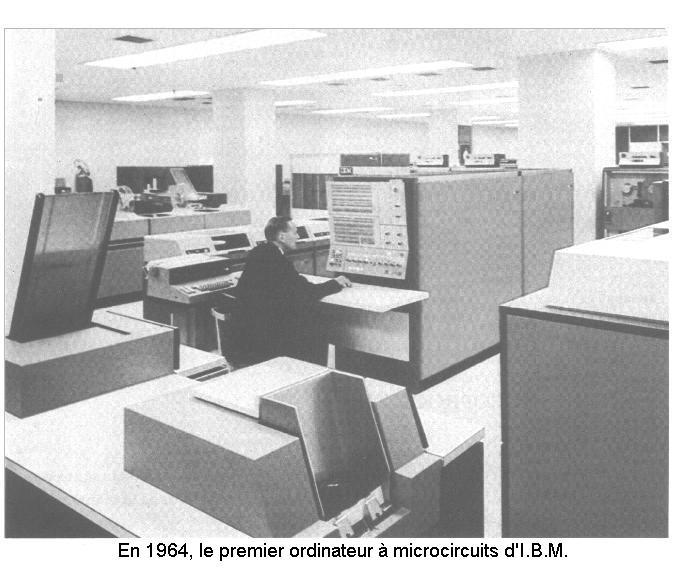Digital Machines and Computers :
PREFACE
The digital technique (or digital, term that we will preferably use because it is now standardized) is that of microelectronic circuits, using the binary language. Its evolution is closely linked to scientific research leading to new technologies.
There are elements of digital technology in very different sectors such as :
![]() railway networks
railway networks
![]() telephone exchanges
telephone exchanges
![]() aeronautics.
aeronautics.
The coordination of rail switches and automatic telephony were the first applications of Boolean algebra, the basis of all operations performed in digital technology.
Thanks to this algebra, the organization of these systems is such that they make basic decisions that resemble those of the human brain.
With automation, the logical devices, which were originally all mechanical, then electromechanical, were replaced by electronic systems and digital technology was perfected : circuits becoming smaller, more efficient, so able to perform more and more complex operations.
These circuits were called "digital" of the English term "digit" which means digit. We will designate them under the name : digital circuits.
At the same time, mechanical or electromechanical systems also improved, but did not compete with electronics in terms of speed and miniaturization. They still keep some applications. In industrial settings, pneumatic systems (using air) are often used, which sometimes combine with electronic systems.
Fluidics, a technique in which the circulation of a fluid (liquid or gas) is developed with the appearance of the "fluidistor". These circuits do not consist of electrical conductors, but tubes and internal cavities of appropriate shapes, so as to perform operations similar to those of electromechanical or electronic switches.
The fluidistor uses the principle of jet deviations, combined with the effect of walls (Coanda effect used in some aircraft engines).
Some prototypes of calculators were even elaborated in this technology, but their slowness, their unreliability and their dimensions were a big handicap to their development, and quickly made them forget.
Today, when we talk about "digital technology", we generally think only of electronic applications and the multitude of microcircuits implemented.
All the technological developments of this technique are oriented towards a greater integration of the circuits, thus allowing a wider diffusion.
In order to better understand the evolution of these systems, it is therefore not irrelevant to make a historical shortcut of the evolution of electronics from the origins of electricity to the present day, since it is widely used. The evolution of digital technology applied to computing will then be presented. Examples of the generalization of this technique and the use of the microprocessor will then be given.
![]() HISTORIQUE (Back to the 12th digital theory lesson)
HISTORIQUE (Back to the 12th digital theory lesson)
1. - ELECTRICITY
The discovery of electrical phenomena
700 years J.C., Thales notes that yellow amber has the property of attracting light bodies by friction on the skin of a cat.
1. 1. - ELECTROSTATIC
In the fifteenth century, English Gilbert found the properties of amber in insulating substances : resin and glass.
The laws of electrostatics are established by Coulomb then Faraday in 1785.
1.2. - ELECTROKINETICS
In 1790, Galvani made the first experiments that led Volta to discover, in 1800, the first electric battery.
The fundamental laws of electrokinetics are established by Ohm in 1827 and Pouillet in 1837.
In 1833, Faraday established the laws of electrolysis.
In 1841, Joule established the laws of the thermal effect.
In 1848, Kohbrausch defines resistivity.
1.3. - ELECTROMAGNETISM
In 1880, Oersted established the first laws linking electromagnetic and electrical phenomena.
Laplace and Ampere dictate the laws governing the interaction of magnetic fields on the currents.
Faraday discovered induction in 1831, Lentz established the laws in 1834. In 1832, Henry studied self-induction.
1.4. - INDUSTRIAL APPLICATIONS
The first motor is due to Barlow in 1828, the first generator to Ampere in 1832. In 1856, Siemens invents the dynamo, but Gramme produces for the first time direct current in 1869 to its ring collector.
In 1878, Edison invented the incandescent lamp.
In 1884, Gaulard invents the transformer.
Electronics, daughter of electricity is the science that uses and controls the movement of electrons in semiconductors, vacuum and gases.
2. - ELECTRONICS
This one sees quickly evolve the components which it uses.
Its evolution was even faster than that of electricity, mainly since the end of the Second World War.
This is why we will recall it by means of a table :
1817 Berthesius identifies Selenium
1887 Hertz discovers the photoelectric effect
1888 Hertz discovers electromagnetic waves
1891 William Shockley, Bell Labs, Baptizes the Smallest Negative Charge Corpus : Electron
1897 John Joseph Thomson experimentally discovers the electron
1901 Richardson discovers the thermononic effect
1904 Flemming invents the diode
1907 Lee de Forest invents the triode
1915 Schottky invents the tetrode
Bernard Tellegen invents the pentode
1923 Lossev realizes a zincite crystal oscillating circuit
1928 Lilienfeld studies the action of an electrostatic field on an electric current
1930 Weber controls the emission of electrons in a semiconductor
1930 French Tetzner invents first field effect transistor : technetron
1930 Holst, Van Geel, Pohl, Hilsch, Voigt, Koch study transistor theory
1948 - 1950 Teal and Pfann succeed in the laboratory Bell, to produce silicon, whose purity reaches 99.99999%
1948 Bardeen, Brattain, Shockley (Bell System Laboratories) invent the transistor junction
1950 Teal manufactures the first commercially available junction transistor
1957 - 1958 Series production of the field effect transistor by Walmark at R.C.A., by Tetzner at C.G.E.
1958 First integrated circuit manufactured by Kilby at Texas Instruments
1962 First silicon substrate field effect transistor
1971 Texas Instruments manufactures the first integrated calculator with a single chip or puce
1971 Intel manufactures the first microprocessor : the 4004
1980 L.S.I (large integration) technologies allow the integration of 2 000 to 8 000 transistors per chip
1990 V.L.S.I technologies (very large integration) allow the integration of 1 billion transistors per chip. (The Japanese have already invested $ 100 million in this technique).

![]() 3. - DIGITAL
MACHINES AND COMPUTING
3. - DIGITAL
MACHINES AND COMPUTING
Two thousand JC, the Chinese already knew the binary number.
The abacus seems to be the oldest calculating machine.
3. 1. - MECHANICAL MACHINERY
The first machine used to calculate is Schikurt's in 1623.
The first real calculator is attributed to the French Pascal who built it in 1642. It only made additions and subtractions and was of course mechanical.
In 1673, the German philosopher Leibniz designed a calculator to perform also multiplications and divisions. However, it will be necessary to wait until the end of the XIXth century so that are made calculators on the model of that of Leibniz ; they will be used until the Second World War.
Yet it was in 1883 that the English Babbage developed the project of a computer for general use, whose structure closely resembles that of a modern computer. Too far ahead of the technological possibilities of its time, this machine could not materialize the dreams of its author.
Examples of embodiments using the concept of memorization and program include the barbarian organ that broadcasts pre-recorded music on paper, and the Jacquard loom that performs the weaving in a pattern stored in a paper tape perforated.
3. 2. - RELAY MACHINES - MECHANOGRAPHY AND SCIENTIFIC CALCULATION
Logical reasoning was studied by the Greek Aristotle 400 years J.C., then by Leibniz in the seventeenth century. In the eighteenth century, the Swiss Euler gave a graphic illustration of this reasoning.
But it was the Irish philosopher and mathematician Georges Boole (1815 - 1864), who in 1854 laid the foundations of modern logic. He invented a mathematical system defining the rules of numerical computation used in computers (as well as all logical systems).
In the nineteenth century, De Morgan established the theorem that bears his name and, is the basis of all simplifications of logic schemes. Boolean algebra is then only a mathematical curiosity.
In 1890, the American H. Hollerith develops new machines for the census of the population of the United States. Employee of the Computer Tabulating Recording Company became in 1924 I.B.M. (International Business Mecanical), he invents the punch card that will be the basis of "mechanography" during the first half of the 20th century.
The analog calculators are born in experimental form for the scientific computing around 1925 (Busch), while the binary system initially proposed by Bacon in the 16th century and taken over by Gray in the U.S.A, allows the creation of mechanical calculators (1925 - 1930).
In 1936, the Japanese Nakasima and Hanzawa, then the American Shannon in 1938, discovered that Boolean algebra could be of great service ; for the rational study of switching circuits in automatic telephony.
Until the Second World War, computers remained mechanical and their development remained linked to accounting and scientific applications.
We can cite :
![]() in 1938 the Z1 binary calculator of Conrad Zuse in Germany.
in 1938 the Z1 binary calculator of Conrad Zuse in Germany.
![]() in 1944 the calculator MARK 1 by Howard Aiken at Harvard University (achievement I.B.M.).
in 1944 the calculator MARK 1 by Howard Aiken at Harvard University (achievement I.B.M.).
But the war stimulates research in the field of computers.
Projectile trajectory calculations become more and more complicated as their speed increases. Air warfare requires great speed to make these calculations ; either to direct artillery fire or to drop bombs from planes.
Efforts are focused on anything that can improve the speed of calculation.
The most powerful relay computer, the Bell Model III, uses nine thousand relays. It weighs 10 tons, multiplies in 1 second and divides in 2.2 seconds.
We then turn to electronics.
3. 3. - FIRST GENERATION : EMPLOYMENT OF THE VACUUM TUBE (1950)
In 1947, the first generation computer ENIAC (Electronic Numerical Integrator And Computer) of Manchly and Eckert is truly the first electronic computer. It is much faster than Model III, multiplying in about 2.8 milliseconds. It uses 18 000 electronic tubes, occupies 135 m2, weighs 30 tonnes and consumes 150 kW.
ENIAC has cost half a million dollars, and the price of the following computers will be even higher.

Belong to "this generation" : EDVAC (Princeton University) ; Bull GAMMA 3, 603-SSEC - 702 - 650 - 704 - 709 of I.B.M. and the most famous of them is UNIVAC 1 from Remington Rand.
At the end of the Second World War, electronic computers no longer covered by military secrecy can be marketed freely and disrupt the industrial world.
Many computers (mainly in England and U.S.A.) are developed. They use electronic tubes and relays.
Other researchers will quickly improve the computer, thanks to the work of Von Neumann (Princeton University).
Around 1950, computers evolve and we begin to compare their mechanism to that of the human brain.
The proposed coding and decoding methods bring out one of the most important of them : the PCM (Pulse Code Modulation) method, filed by Alan Reeves in 1938.
3. 4. - SECOND GENERATION : USE OF THE TRANSISTOR (1960)
In 1950, the manufacture of the transistor is made possible by new silicon purification processes.
The sixties are those of the space adventure as well as the Ballistic Missile. At this time, the speed of calculation of the systems being sufficient, the enemy number one is the weight and the dimensions of the systems.
The use of transistor circuits is generalized.
Among the devices of this generation, we can mention :
![]() the Gamma 60 (from Bull)
the Gamma 60 (from Bull)
![]() the PDP1 (Digital Equipment)
the PDP1 (Digital Equipment)
![]() the 1401 - 1620 - 7090 (of I.B.M.)
the 1401 - 1620 - 7090 (of I.B.M.)
![]() CAB 500 (from the S.E.A.)
CAB 500 (from the S.E.A.)
3. 5. - THE THIRD GENERATION : THE USE OF INTEGRATED CIRCUITS
In order to gain more weight, we try to put several elements in one box. Thus is born the first integrated circuit which contains four transistors and two resistors on a single chip of semiconductor.
In 1964, I.B.M. launches the first computer using integrated circuits.
3rd generation computers are becoming faster and more compact.

3. 6. - FOURTH GENERATION (1980) Thanks to the microcircuits, the computer becomes a mini computer, then, with the use of integrated circuits including a greater number of transistors, microcomputer (more than 10 000 transistors in the same housing). A modern microcomputer has under the volume of a television the same power (about 110 to 150 Watts).

 Click here for the next lesson or in the summary provided for this purpose. Click here for the next lesson or in the summary provided for this purpose. |
|
 Previous Page Previous Page |
 Next Page Next Page |
Nombre de pages vues, à partir de cette date : le 27 Décembre 2019
Envoyez un courrier électronique à Administrateur Web Société pour toute question ou remarque concernant ce site Web.
Version du site : 10. 4. 12 - Site optimisation 1280 x 1024 pixels - Faculté de Nanterre - Dernière modification : 02 Septembre 2016.
Ce site Web a été Créé le, 14 Mars 1999 et ayant Rénové, en Septembre 2016.
 Historical
Historical